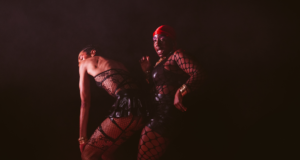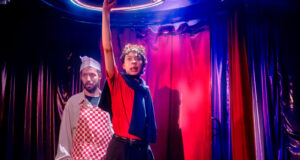Surreal, hilariously entertaining and a poignant, insightful journey through the world of mental illness.Summary
Rating
Excellent
Lisa (Leah Harvey) is dancing wildly in the kitchen when Victor Hesse (Leander Deeny) arrives. He explains that the reason she’s not been quite herself recently is that she lost an hour on her flight back from New York. Of course! Well, that makes perfect sense. All she has to do now is to go to the land of Dissocia to recover it. But something is not quite right. Victor’s story is peculiar; his speech disrupted and irregular. Things are about to get weird.
Anthony Neilson’s extraordinary script is a stunningly insightful exploration of mental illness. The first half sees Lisa descend à la Alice in Wonderland into a surreal world. It’s enormously funny, as she meets quirky, exaggerated characters, played by a talented ensemble of actors. But as we watch, disturbing elements creep in. They are trying to keep her there. We become conscious of paranoia and insecurity, and suddenly there’s the threat of horrific sexual violence. Reality seems in flux, with Harvey beautifully playing a likeable, yet clearly vulnerable, Lisa at the centre of it all.
Emma Baggott’s direction is sharp and choreographed, pushing the excellent cast to extremes of performance, from laugh-out-loud comedy to heart-breaking poignancy. In this bewildering world there’s slapstick hotdog hurling besides shocking sexual threat, and then exquisite acapella song.
A spectacular set design by Grace Smart reflects the degenerating state of Lisa’s mind, taking us down the rabbit hole with her. It is fascinating, surprising and innovative, building layer upon layer of absurdity until it reaches extremes of theatricality and garishness. Like Lisa’s mental condition it is sometimes unstable; collapsing unexpectedly, or made from fragile materials. Suddenly in the second act we’re somewhere completely different – in a psychiatric ward that is clinically realistic, cold and detailed.
Impressive lighting design from Lucía Sánchez Roldán further draws the audience along on the journey, working immensely hard to support and illustrate the storyline. A giant segmented halo of light hangs over the stage, initially suggesting a clockface and speaking toward themes of time. Lit in changing colours, with lights moving, changing pace, it emphasises the irregularity of Lisa’s experiences when in Dissocia, but also visually suggests the rabbit hole. Its meaning then alters totally in the second act, appearing like an enormous, clinical, medical light.
Indeed, varied interesting lighting is used throughout to illustrate Lisa’s distorted reality: flashing lamps, edging into the auditorium, signal imminent emergency, whilst blinding strobes emphasise the searing distress of mental instability. It swings from the extravagantly excessive and stylised to subtle and nuanced, tracking Lisa’s state of mind. Importantly, the choice to absent and restrict illumination in the second half underscores the visceral reality of mental illness, as Lisa’s story is literally seen in a different light. Temporal shifts are punctuated by violent flashes, opposing complete darkness. The design performs Lisa’s journey alongside her, with the audience becoming immersed in it too.
Contrasting with the extremes of the first half, Neilson uses absolute economy in the second act. Tiny details speak volumes about psychiatric treatment; the inconsistency of ever-changing doctors; isolation and lack of significant human interaction; the sister (Dominique Hamilton) challenging Lisa to just pull her socks up. The audience is better equipped to feel and understand Lisa’s issues for having taken the journey to Dissocia with her. Positively, a tiny moment of hope for next Sunday’s visit suggests there may be brighter days ahead.
This is a magnificent, gloriously full and rounded production that will take you through a multitude of emotions and back again. Surreal and absurd it may be initially, but ultimately it is a sensitively respectful examination of the underworld of mental illness.
Written by: Anthony Neilson
Directed by: Emma Baggott
Set & Costume Design by: Grace Smart
Lighting Design by: Lucía Sánchez Roldán
Composed & Sound Design by: Alexandra Faye Braithwaite
Movement & Intimacy Direction by: Angela Gasparetto
The Wonderful World of Dissocia plays at Theatre Royal Stratford East until 15 October. Further information and bookings can be found here.
 Everything Theatre Reviews, interviews and news for theatre lovers, London and beyond
Everything Theatre Reviews, interviews and news for theatre lovers, London and beyond



